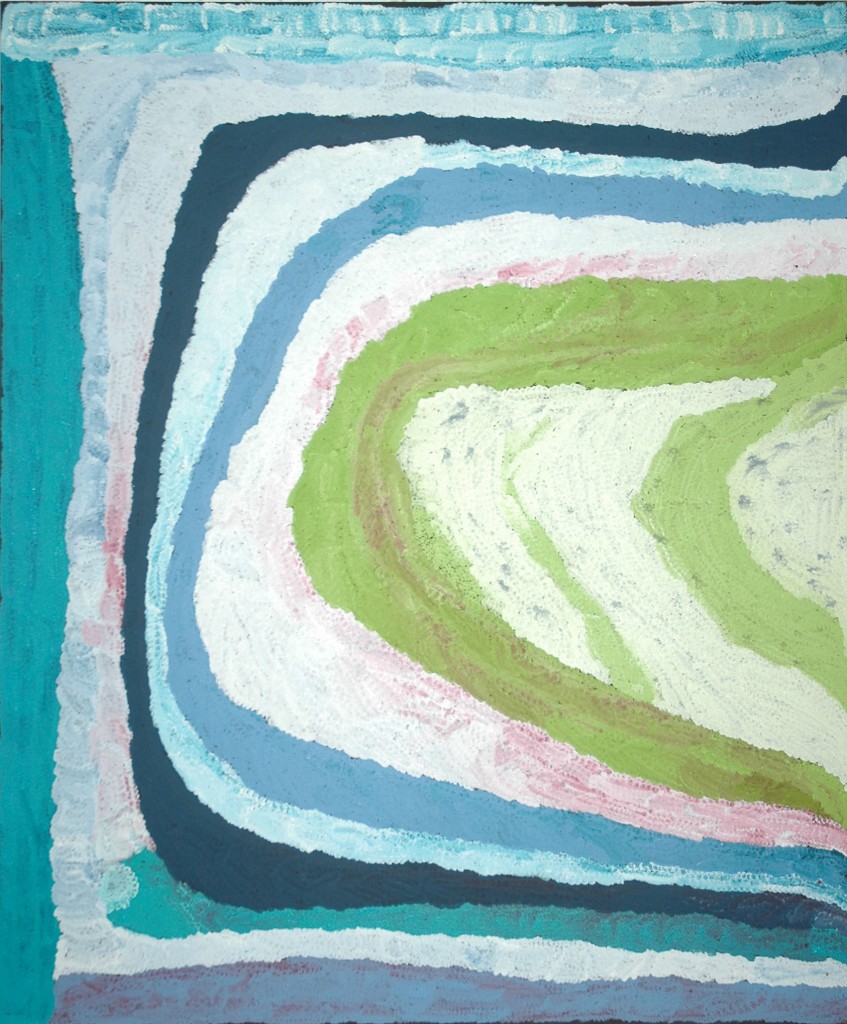Lydia Balbal, a Mangala woman, was born around 1958, in the remotest part of the Great Sandy Desert, near Punmu. She spent her childhood in these ancestral lands, untouched by exterior civilizations, until 1972, when her family left the desert to settle at the La Grange Mission, in the coastal town of Bidyadanga.
Lydia’s favourite subjects are natural sacred sites, and more particularly water holes located in the Mangala and Yulparija areas, which she depicts through abstract overlappings of large dots or wide stripes of shading off colours.
Lydia’s painting entitled Pikarong is a typical instance of the personal aesthetics she has progressively elaborated: it presents a unique combination of ancestral traditions with innovation, by holding together on the canvas the strength of the desert age-old wisdom, knowledge and mythical beliefs, and the freedom and self-confidence of the artist’s unprecedented, bold chromatic contrasts.
Indeed, Pikarong deals with a traditional subject matter. It shows a site intrinsically linked with the Aboriginals’ everyday life, both practically and symbolically speaking. Firstly, Pikarong is essential to the survival of the Aboriginal peoples living in the Desert: it is a jila, which means “living water” in Lydia’s language. And water, as a vital resource, occupies a primordial place in the life and imagination of the Desert peoples. For this very reason, it is a recurring theme in Lydia’s work: this is where she was born, and the memories of hunting scenes, when Lydia would follow the tracks of king brown snakes with her family, influence her aesthetic reflection. Here, the lines stand for the tracks the reptile left in the sand, among other things. Furthermore, water and jilas are omnipresent in the Desert myths and traditional narratives, for they were created by Ancestor Spirits in the Dreamtime. Because of this extremely strong connection with mythical creatures, water holes are replete with spiritual symbols and stories. They serve as the preferred stages for the performing of ritual ceremonies for the transmission of Aboriginal customs and beliefs. All these traditional elements, which permeate Lydia’s painting Pikarong, contribute to making the artist a direct heir of the aboriginal artistic practices of the Desert.
However, although Lydia depicts the desert country and imbues her works with traditional symbolism, she detaches herself from her Bidyadanga predecessors by adopting a radically new perspective, shaped by her (hi)story. “I’m painting underground,” she once explained. “What’s underground. Upside down: water, rockholes, lines beneath the sand-dunes.“[1] What Lydia proposes is a differentiated experience of place. She recomposes the Pikarong rockhole from beneath: the background canvas, covered in black paint, stands for the earth’s exterior crust, and Lydia turns her gaze towards the surface, from the bottom of the well of living water.
Moreover, Lydia’s mesmerizing expanses of colour which sensuously unfold before the beholder’s eyes and prevail over strictly figurative forms, are pregnant with totally new elements. The dominant range of deep and intense turquoise-blue tones which Lydia pours out on the whole canvas, exemplifies her take on novelty. These cool colours, breaking with the Desert’s traditional use of natural pigments and ochre, conjure up the ocean, as seen from the coast in Bidyadanga. As for the white expanses, they suggest both the waves’ foam and the salt crusts shining in the sun where the water withdrew. The sweeping, free moves Lydia creates catch the onlooker into the heart of a moving wave of colourful lines.
The introduction of this new palette of saltwater colours in Pikarong is the direct artistic result of Lydia’s exodus out of the Desert, and of her discovering the coastal landscapes of Bidyadanga when she arrived at the Mission. Entrusted with the passing over of her knowledge of the Australian land, Lydia mingles the different viewpoints she successively adopted in the course of her life shared between the Desert and the Australian north-west coast. Pikarong thus incorporates softer hues, associated with the traditional depiction of desert sceneries. Pink tones, embedded within the blue stripes, reveal themselves through transparency effects, visually echoing the hierarchy of interpretation levels of the founding myths of Aboriginal cultures. The imbrication of multiple chromatic tones embodies the strata of knowledge, successively accessed as one progresses in his/her initiation.
Finally, Lydia Balbal modernizes the dot, one of the most famous patterns of the aboriginal iconographic repertoire, which has been represented on the sand, on rocks or on the bodies of rites’ performers for thousands of years, and is currently celebrated in the exhibition “Tjukurrtjanu: The Origins of Western Desert Aboriginal Art”, at the Musée du quai Branly. Lydia re-actualizes the traditional motif by minutely working and shaping the texture of the paint she applies on the canvas, in order to invite the viewer to renew his/her gaze and his/her understanding of Aboriginal painting.
Unsurprisingly, then, Pikarong – the composition of which functions as a fractal, taking the viewer on an emotional journey through the vastness of Australian sceneries, be they geographical, spiritual or mythical – was crowned with success. It was chosen to represent contemporary Aboriginal creation in the exhibition “remix”, held at the Art Gallery of Western Australia in 2011. IDAIA is therefore immensely proud of presenting this artwork in Paris, at the Passage du Grand Cerf.
Bénédicte Vachon, Assistant Curator
Reference:
1) Rothwell, Nicolas. “Turning Landscape on its Head”, The Australian. December 8th, 2008
About the Author:
Bénédicte Vachon, Assistant Curator, Paris, France
Learn more about artist Lydia Balbal:
Lydia Balbal had her first solo exhibition outside Australia with IDAIA in Paris in Oct – Dec 2012.
Read more about this exhibition, or visit the gallery of Lydia Balbal’s paintings.
Artwork © The Artist, Photo © IDAIA
